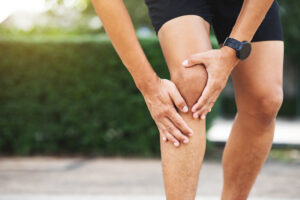March 27, 2024
Inner knee pain without swelling can be caused by a variety of factors, including sports injuries and arthritis. Once you identify the root cause of your knee pain, you can seek the right type of treatment that can make your symptoms go away.
Here are the top seven reasons for pain that occurs on the inside of the knee with no swelling and how to contact Healthcare Associates of Texas if you need treatment.
 1. MCL injury
1. MCL injury
The medial collateral ligament (MCL) is a flat band of tissue that runs along the outside of the inner knee. Its job is to stabilize the knee joint. If the MCL becomes overstretched for any reason, it can become torn or sprained.
Injuries to the knee ligament account for about 40% of all knee injuries, and MCL injuries are the most common type.1 The majority of MCL injuries occur in contact sports and skiing. In fact, 60% of knee injuries that occur while skiing affect the MCL.1
Other symptoms of inner knee pain from an MCL injury include:
- Popping sound at the time of the injury
- Locking knees
- Bruising and tenderness in the knee
- Instability in the knee when standing or walking
- Stiffness in the knee
2. Osteoarthritis
Also known as “wear and tear” arthritis, osteoarthritis is the most common type of arthritis and affects more than 32.5 million U.S. adults.2 It can cause pain and stiffness in any joint, though it occurs most frequently in the hands, hips, and knees.2
Osteoarthritis usually develops gradually over time. It can occur due to frequent repetitive movements, such as bending the knees while gardening or playing sports. It can also occur with obesity due to the way excess weight puts extra stress on the knees.
Common signs and symptoms of osteoarthritis in the knee include the following:
- Pain and aching in the knee
- Stiffness in the knee
- Decreased range of motion in the knee
- A feeling of looseness in the knee
- Buckling of the knees
- Grinding or scraping noise in the knee
 3. Rheumatoid arthritis
3. Rheumatoid arthritis
Rheumatoid arthritis is different from osteoarthritis in that it is an inflammatory and autoimmune disease. In this disease, your immune system mistakenly attacks healthy cells in a way that causes joint pain. It usually affects more than one joint but occurs most frequently in the hand, wrist, and knee joints.3
If your inner knee pain is caused by rheumatoid arthritis, you may also sometimes feel pain in the outer part of the knee. In addition to causing knee pain, this disease may also cause symptoms including:
- Stiffness in the knee
- Tenderness in the knee
- Weight loss
- Fever
- Extreme tiredness
- Weakness
4. Medial meniscus injury
The meniscus, or menisci (plural), is cartilage that cushions the inner side of the knee joint. Each of your knees has two menisci. An injury to the medial meniscus can lead to damage or a tear in this cartilage. This can cause pain in the inner knee that may or may not occur with swelling.
A medial meniscus injury can occur suddenly due to a blow to the knee or when awkwardly twisting the knee. It may also occur gradually over time due to overuse of the knee.
Symptoms of a medial meniscus injury in the knee include:4
- Popping noise or sensation in the knee at the time of injury
- Stiffness in the knee
- Sharp pain when twisting the knee
- Instability and poor balance
- Locking knees
- Difficulty with straightening the leg
5. Pes anserine bursitis
“Pes anserine” refers to the three tendons that support the medial part of the knee. “Bursitis” refers to inflammation of the bursa, or bursae (plural).
Bursae are small sacs filled with fluid that help reduce friction between your muscles and ligaments. There are several bursae in your knees. Therefore, pes anserine bursitis is inflammation of the bursa in the pes anserine.5 When a bursa becomes inflamed, it produces extra fluid that can cause inner knee pain.
Pes anserine bursitis can be caused by an injury to the knee, such as an MCL tear. It can also be caused by other conditions including obesity, diabetes, and osteoarthritis.5
Other symptoms you may experience with this condition include the following:
- Stiffness in the knee
- Weakness in the knee
- Tenderness in the knee
- Decreased range of motion in the knee
6. Medial plica syndrome
The medial plica is a small, thin fold in the joint lining located in the medial part of the knee. Medial plica syndrome occurs when this fold becomes irritated to cause inner knee pain.
Irritation to the medial plica is caused by repetitive flexing of the knee. More than half of people who get medial plica syndrome perform strenuous activities that involve repetitive flexing.6 Flexing can cause this fold to thicken and get stuck between bones. This can trigger pain in the inner knee that may occur with or without swelling.
Other symptoms of medial plica syndrome include:
- Locking knees
- Cracking or clicking sound in the knee
- Pain that gets worse when doing activities such as squatting or climbing stairs
- Grating or grinding sensation when flexing the knee
7. Patellofemoral pain syndrome (PFPS)
PFPS is one of the most common causes of knee pain.7 This condition accounts for between 25% and 40% of all knee problems treated by doctors who specialize in sports medicine.7
Also known as runner’s knee, PFPS typically causes pain at the front of the knee, though it can also cause inner knee pain. It usually occurs due to trauma to the kneecap or due to overuse with activities such as running and jumping.7
In addition to causing inner knee pain, PFPS may also cause:
- Pain that gets worse when squatting, running, sitting, or climbing stairs
- Instability in the knee
 Is it possible to prevent inner knee pain without swelling?
Is it possible to prevent inner knee pain without swelling?
Yes, it may be possible to prevent inner knee pain with or without swelling. For instance, if you play sports, you can strengthen the muscles around your knee and take sports safety precautions to avoid injuries. However, it is not always possible to prevent arthritis, especially if it is genetic.
Follow these tips to prevent injuries that cause inner knee pain:
- Work with a sports or athletic trainer to improve your form and sports techniques.
- Do exercises that improve your strength, balance, and flexibility.
- Stay active and exercise regularly.
- Maintain a healthy weight.
- Lose excess weight.
- Warm up properly with dynamic stretching before workouts and sports activities.
- Save static stretching for after your workout.
- Wear a knee brace if you have a weak or unstable knee.
- Avoid activities that require repetitive use of the knee joint.
- Wear properly fitting athletic shoes that are appropriate for your activity.
Follow these tips to reduce your risk for arthritis in the knee:
- Lose excess weight.
- Maintain a healthy weight.
- Exercise regularly.
- Include strength training and weight-bearing exercises in your fitness routine.
- Eat lots of highly nutritious foods, including anti-inflammatory foods. Foods that may prevent or reduce inflammation include broccoli, berries, and fatty fish (such as salmon, tuna, and sardines).8
- Eat far fewer foods that contain trans fats and saturated fats.
- Stop smoking.
- Drink less alcohol.
- Improve your posture.
- Adhere closely to your treatment regimen if you are diagnosed with arthritis.
What to do if you have inner knee pain without swelling
Many injuries that do not cause swelling — including those to the inner knee — are usually only mild. If your injury is mild, you may be able to treat yourself at home using remedies such as RICE (rest, ice, compression, and elevation) along with over-the-counter pain relievers. However, if you think your injury is severe or your symptoms get worse, it may be time to see a doctor.
Make an appointment with your doctor if you are experiencing any of the following:
- You cannot put weight on the leg with inner knee pain
- You have severe pain in your inner knee, even when resting
- Your knee is locking, clicking, or giving way
- Your knee is hot or red
- You cannot move your knee
- You have a fever
You should also see your doctor if you think you may have arthritis. Arthritis is a chronic condition that will not go away on its own, even if you receive treatment. However, treatment for arthritis may help you manage your condition and reduce symptoms and the frequency of flares.
What are the best treatments for inner knee pain?
The treatment you receive for inner knee pain will depend mainly on the underlying cause of your knee pain. For instance, if you have a mild injury, your doctor may recommend RICE or physical therapy to improve strength and mobility in your knee.
Severe knee injuries may require months of physical therapy and rehabilitation. In severe cases, surgery may be necessary. Arthritis cannot be fully cured, but treatments may significantly reduce your symptoms. Medications, injections, physical therapy, and joint replacement are common treatments for arthritis.
Regardless of the root cause of your inner knee pain, your doctor can work with you to find the best treatment.
Request an appointment with Healthcare Associates of Texas today to receive treatment for any medical condition, including inner knee pain. We offer many primary care services, such as wellness exams, screenings, and more.
References
- Naqvi, U. (2023, July 17). Medial collateral ligament knee injury. StatPearls – NCBI Bookshelf. https://www.ncbi.nlm.nih.gov/books/NBK431095/
- Osteoarthritis (OA). (2020, July 27). Centers for Disease Control and Prevention. https://www.cdc.gov/arthritis/basics/osteoarthritis.htm
- Rheumatoid Arthritis (RA). (2020, July 27). Centers for Disease Control and Prevention. https://www.cdc.gov/arthritis/basics/rheumatoid-arthritis.html
- Raj, M. A. (2023, July 17). Knee meniscal tears. StatPearls – NCBI Bookshelf. https://www.ncbi.nlm.nih.gov/books/NBK431067/
- Mohseni, M. (2023, April 22). Pes Anserine bursitis. StatPearls – NCBI Bookshelf. https://www.ncbi.nlm.nih.gov/books/NBK532941/
- Griffith, C. J., & LaPrade, R. F. (2007). Medial plica irritation: diagnosis and treatment. Current Reviews in Musculoskeletal Medicine, 1(1), 53–60. https://doi.org/10.1007/s12178-007-9006-z
- Bump, J. M. (2023, February 13). Patellofemoral syndrome. StatPearls – NCBI Bookshelf. https://www.ncbi.nlm.nih.gov/books/NBK557657/
- Eating to Reduce Inflammation. (2018, July 27). U.S. Department of Veterans Affairs. https://www.va.gov/WHOLEHEALTHLIBRARY/tools/Eating_to_Reduce_Inflammation.asp
DISCLAIMER
The information featured in this site is general in nature. The site provides health information designed to complement your personal health management. It does not provide medical advice or health services and is not meant to replace professional advice or imply coverage of specific clinical services or products. The inclusion of links to other web sites does not imply any endorsement of the material on such websites.
Ready to become your healthiest self?
Get tips delivered to your e-mail inbox every month. Let’s get happier and healthier together!



